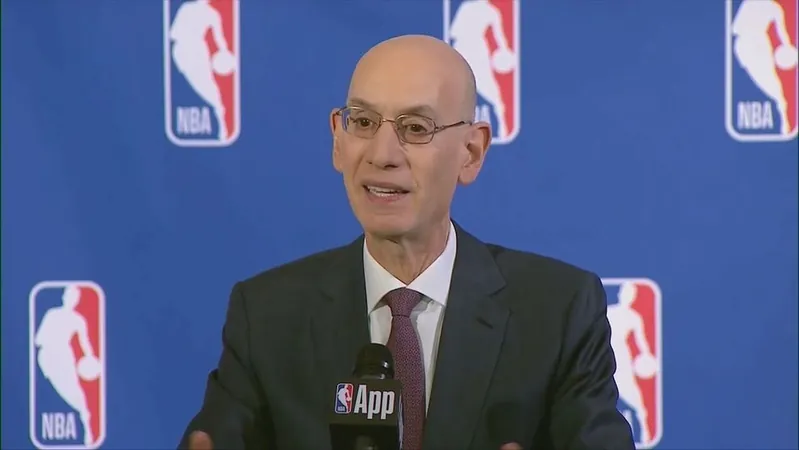
USL President Paul McDonough Predicts Promotion and Relegation in US Soccer by 2028 - A Game-Changer for the Sport!
2025-03-19
Author: Kai
The United Soccer League (USL) is making headlines as it announces monumental changes that could reshape the landscape of soccer in the United States. In a recent board meeting held in Atlanta, the USL, which oversees most lower-division soccer in the country, has set the stage for the implementation of promotion and relegation within its leagues. If successfully enacted, this development would mark the first instance of such a system in the modern era of US soccer.
A Stride Toward Global Standards
In an exclusive interview, USL President Paul McDonough revealed the reasoning behind this groundbreaking decision. Following discussions about launching a new league at the same level as Major League Soccer (MLS), the topic of promotion and relegation quickly emerged, reflecting a strong desire amongst owners for a more competitive structure. “We’ve officially adopted the concept of promotion and relegation,” McDonough confirmed, emphasizing that while this is a significant step, extensive planning and discussion still lie ahead.
Under the new structure, teams will face the threat of relegation if they finish at the bottom of their division while keeping an eye on the potential for promotion to higher tiers. This exciting dynamic aims to increase competition and drive fan engagement, as matches will carry greater significance with stakes tied to climbing or falling within the league structure.
Setting a Timeline: Could It Happen Sooner?
The target date for the start of this system has been preliminarily set for 2028; however, there are discussions about potentially rushing the timeline to 2027, depending on the establishment of the new division one league. Regardless, this timeline will be shaped by the ongoing discussions amongst league owners and will not be finalized until further analysis of the implications and logistics are carried out.
McDonough highlighted that while there are potential roadblocks—such as financial disparities for teams promoted to a higher division—the overall sentiment is optimistic. “There’s a lot of work that goes into it, but there’s a commitment to make it happen,” he noted.
Raising the Stakes for Teams and Fans
Promotion and relegation could drastically change the approach to games within USL. McDonough pointed out that fans are craving meaningful matches where every point counts. The current scenario sometimes leads to “dead rubber” games with little at stake, decreasing interest and attendance. By introducing stakes through promotions and relegations, every match could become a battle for survival or advancement, revitalizing the competitive spirit among teams and fans alike.
However, this new system also raises a critical question: how will USL handle teams that achieve promotion but don’t meet the necessary standards for the higher division? McDonough reassured that governance policies would safeguard against such scenarios, and conversations with US Soccer and other governing bodies will be crucial in ensuring that standards are met.
The Future of US Soccer: Engaging Investors and Fans
The introduction of promotion and relegation is seen as a way to make the USL more appealing not just to fans, but to potential investors as well. McDonough shared that discussions with investors indicate a positive response to this structure, as it aligns US soccer with global standards, sparking increased interest in creating franchise opportunities within the new division one league.
While many owners are enthusiastic about this direction, some have expressed concerns about the pace of change. McDonough acknowledged this feedback, indicating that further discussions will be needed to address the various viewpoints and ensure a smooth implementation process.
A Crucial Step for Development
Ultimately, promotion and relegation could enhance player development within the US soccer ecosystem by providing more competitive fixtures. As the league matures and becomes more relevant, player growth and marketability are expected to improve.
As these discussions progress and the landscape of American soccer changes, one thing remains clear: the shift towards promotion and relegation could redefine the future of soccer in the US, elevating the experience for players, teams, and fans alike. With the USL leading the charge, the path to a more vibrant and competitive soccer culture in America is a step closer to reality. Keep an eye on this development—it might just transform the sport as we know it!



 Brasil (PT)
Brasil (PT)
 Canada (EN)
Canada (EN)
 Chile (ES)
Chile (ES)
 Česko (CS)
Česko (CS)
 대한민국 (KO)
대한민국 (KO)
 España (ES)
España (ES)
 France (FR)
France (FR)
 Hong Kong (EN)
Hong Kong (EN)
 Italia (IT)
Italia (IT)
 日本 (JA)
日本 (JA)
 Magyarország (HU)
Magyarország (HU)
 Norge (NO)
Norge (NO)
 Polska (PL)
Polska (PL)
 Schweiz (DE)
Schweiz (DE)
 Singapore (EN)
Singapore (EN)
 Sverige (SV)
Sverige (SV)
 Suomi (FI)
Suomi (FI)
 Türkiye (TR)
Türkiye (TR)
 الإمارات العربية المتحدة (AR)
الإمارات العربية المتحدة (AR)